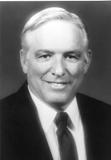Awardee Interviews | Biography: Harold F. Winters
Harold F. Winters

Harold F. Winters attended Eastern Washington University, Biola University and received his B.S. degree in physics from Whitworth College in 1958. He received his Ph.D. in physics from Washington State University in 1963 where he studied "the adsorption resulting from electron impact on gas phase molecules". He has been a member of the Research Staff at the IBM Almaden Research Center since that time except for two sabbatical years; one of the years was spent at the IBM Development Laboratory at East Fishkill where he worked on the development of ion sources for ion implanters; the second sabbatical year was spent as a visiting professor at the University of Odense in Denmark where his research was in the area of surface sciences. He will retire from IBM in September of 1993.
A major contribution of Dr. Winters (with Dr. Coburn) has been in the area of plasma-assisted etching with particular emphasis on developing an understanding of physical and chemical mechanisms. They demonstrated that etching could be achieved outside of the plasma using XeF2 as the reactive gas. They then developed experiments to simulate plasma processes by using directed beams of reactive gas, ions, and electrons. Modulated beam mass spectrometry was used to measure the etch products, reflected incident species, and reaction by-products. XPS and Auger spectroscopy were used to understand surface conditions. These directed beam experiments were very helpful in providing a qualitative understanding of the complex phenomena occurring at surfaces in reactive gas plasmas. One of the focal points of this work was to elucidate the role of energetic ions for inducing chemical etching reactions. This beam work was the forerunner of ion-beam assisted chemical etching applications involving both broad and finely focused ion beams. They demonstrated the role of carbon (and polymeric material in general) in the previously discovered selective etching of SiO2 and in etching directionality by means of sidewall passivation. They have also pointed out the role of feature conductance in high aspect ratio etching and have developed a model to explain the influence of doping on etching reactions. Drs. Winters and Coburn jointly developed a quantitative method for measuring the amount of perfluropolyether lubricant on (or in) disks used in magnetic recording technology. They also developed a model that showed how the interpretation of depth profiling measurements was strongly influenced by the altered chemical composition at the surface generated as a consequence of ion bombardment.
Dr. Winters conducted the first systematic experimental investigation of the physical sputtering of a chemisorbed gas from a surface. He showed that the sputter yields were unexpectedly large and that the energy dependence deviated from that observed for elemental: materials. A collisional model was developed (with P. Sigmund) which suggested that direct collisions between the incoming and outgoing ion and the absorbed gas were important processes leading to sputtering. This view is now generally accepted. Dr. Winters also discovered that there was a large kinetic isotope effect associated with the dissociative chemisorption of methane and ethane. He interpreted his data as indicating that the reaction was completely dominated by quantum mechanical tunneling of hydrogen through a potential barrier. This has been a very controversial result but recent data suggests that the tunneling model is correct. Dr. Winters (with Dr. Kay) found that noble gases were always incorporated into sputter-deposited thin films and suggested mechanisms which led to the effect under a variety of conditions. They suggested that some of this gas incorporation was related to the fact that energetic neutrals were being reflected from the target surface. This insight has been used by many investigators to explain a variety of phenomena both in and out of the plasma. Dr. Winters (with Drs. Donaldson and Bills) developed a method for measuring the total electron impact dissociation cross-section for many of the gases used in materials processing. Much of the cross section data in the literature (7 gases) were provided by these experiments. This data set is used as input for the modelling of reactive gas glow discharges. Dr. Winters (with Drs. Coufal, Eckstein, and Bay) have provided most of the available data (0-4000 eV) for the energy transferred to a solid lattice by ion bombardment as a function of ion mass, target mass and incident ion energy. These data were used by them to provide insight into processes which occur during the deposition of sputtered thin films.
Dr. Winters is a member of the American Vacuum Society, American Physical Society, American Association for the Advancement of Science, American Scientific Affiliation, and the Materials Research Society. Dr. Winters has served the American Vacuum Society as a member of the Program Committee and as a member of the Executive Board for both the Thin Film Division and the Surface Science Division. He has also served as Secretary-Treasurer of the Surface Science Division. He has served a three year term as a trustee with the American Vacuum Society. He is a member of the editorial board for a series of books on plasma-material interactions published by Academic Press. He has also served a three year term on the editorial board of the Journal of Nuclear Instruments and Methods B. He is currently serving a four year term as one of three north American representatives on the IUPAC Subcommittee on Plasma Chemistry. He has also served on several committees sponsored by the U.S. government which provided advice on specific technical issues. In 1992 Dr. Winters received an "Outstanding Achievement Award" (for alumni) from the College of Arts and Sciences at Washington State University. He also received (with John Coburn) the 1983 "Thinkers Award" presented by Tegal Corporation for contributions in the field of plasma etching. Dr. Winters has received several awards from IBM for patents and contributions to various technical areas.